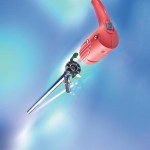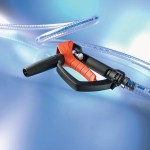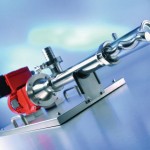Back in 1950, the world’s first electric barrel pump was given the name Flux. The enterprise that subsequently developed under this proprietary name can be considered a pioneer in the field of barrel pump technology. Today, Flux- Geräte GmbH is a specialist in the development and manufacture of pumps for filling and transfer operations. Flux pumps are used in the chemical and pharmaceutical industries as well as in water treatment and food processing. New solutions were recently presented at the Powtech exhibition in Nuremberg.
The history of Flux-Geräte GmbH is typical of many companies that were founded after the Second World War. However, its origins go back much further – to the founding of Mauz & Pfeiffer in Stuttgart-Botnang in 1912. M&P was the oldest German specialist for electric vacuum cleaners and as early as 1926, under the brand name Progress, it developed the first cylinder vacuum cleaner on wheels, which soon became a real bestseller. Straight after the war, the company’s shareholders began to rebuild the destroyed infrastructure in Botnang. Success proved them right and by 1948, Progress Verkaufs GmbH was established under the umbrella of Mauz & Pfeiffer.
Only a year later, in 1949, several students from the University of Karlsruhe launched a company called Phyag KG. With Nikolaus Laing as Managing Director, they set themselves the twin goals of developing technical equipment up to series production standard and generating corporate growth through the sale of patents and the issue of licenses. In 1950, Phyag developed the Flux F 300, the world’s first electric barrel pump.
Ludwig Hahn, Managing Director of Progress, first became acquainted with the Flux pump at a trade fair in 1950 and immediately recognised the potential latent in this invention. He quickly reached a mutual agreement with Laing and acquired all rights to the new barrel pumps as early as 1952. Three years later, Flux-Geräte GmbH was founded.
The rapid rise of Flux as a company began in the sixties. It was hived out from Progress and production was gradually transferred to the production site in Maulbronn. The registered office remained in Stuttgart, however. In March 1962, Herbert Hahn took over the management of the company, whose destiny he was to steer for almost 40 years. Under his leadership, the Maulbronn site was regularly extended and modernised, and Flux also celebrated its first big successes abroad.
On January 1, 2000, after nearly four dec-ades at the helm, Herbert Hahn handed over responsibility for operative business to his nephew, Klaus. The takeover of Cologne manufacturer Sondermann Pumpen + Filter in 2005 and the establishment of a subsidiary in France as well as a holding in Thailand reaffirmed Flux’s position as a global player.
High performance laboratory pumps
With its Juniorflux F 310 and F 314 barrel and laboratory models, Flux offers high-performance laboratory pumps for filling, emptying, transferring and dispensing liquids from narrow necked vessels. These compact pumps, weighing just 2 kg, are easy to handle and can be used in any situation where small quantities of liquid need to be dispensed. The pumps are available in a sealless version made from polypropylene (PP), polyvinylidene fluoride (PVDF) or stainless steel 1.4571 (S). They are predominantly found in laboratories, chemical storage facilities and workshops.
The new Combiflux pumps, inspired by the tried-and-trusted Juniorflux pumps, now provide additional flexibility to lighten the user’s workload. The FEM 3070 motor of these pumps is connected to the pump tube by a special quick-action coupling, which allows the motor to be attached to other pump tubes in a matter of seconds. Only a single motor is therefore required to operate several tubes – even if these are purchased separately. This means universal suitability and saves both time and money. Combiflux pumps are extremely reliable; their high-speed 230 W motor with overload cut-out switch is double-insulated and splash-proof. In addition, the motor guarantees highly precise delivery if a two-step switch is fitted. An integrated attachment hook ensures that the hand tap is safely mounted on the pressure joint. The fact that the outer hose can be easily unscrewed by hand, enabling the Combiflux to be cleaned very quickly and efficiently, is a particular advantage.
Semi-automatic filling
The recently presented filling units offer everything required for safe, quick, semi-automatic filling. In contrast to the Flux hand taps, the valve of these units – which is normally operated manually – has been replaced by a spring valve, which opens under liquid pressure of 0.3 bar. As a result, the filling process can be remotely controlled using a start-stop button on the unit. The filling units are suitable for media that do not contain any solids up to a maximum viscosity of 300 mPas. They can be manufactured form PP, PVDF or stainless steel (S). In combination with a liquid meter with an integrated amplifier and pump, the new units are transformed into a complete filling system.
High-viscosity pumps
High-viscosity pumps from Flux are used for a wide range of liquids with extremely diverse flow properties: oils, fats, greases, paints, varnishes, dispersions, creams, pastes, gels, shampoo, honey, dough mass, chocolate and much more besides. Made from stainless steel, they are designed according to the eccentric worm drive principle and adapted to suit the respective application. Thus, individual customer so- lutions are created for a variety of industries: they conform to the tough operating conditions in plant and mechanical engi-neering, the special requirements in the cosmetic and pharmaceutical industries and the strict hygienic regulations applicable in the food sector. Even pumps with 3A approval can be supplied. Moreover, the XA and XB model ranges are approved for Zone 0, i.e. for the delivery of highly flammable liquids.
The ingenious design of these ranges is conducive to quick and easy dismantling and cleaning. The lack of cast parts and voids ensures contamination-free operation. Mechanical seals, stators and eccentric worms are adapted to the specific application. To restrict the weight to a minimum – a key aspect for transport – the pumps are offered in a gearing design featuring a lightweight, high-power commutator and compressed-air motor as well as in a bearing flange design with a robust AC motor. The eccentric worm pumps in the F 550 TR and F 560 TR model ranges can be mounted on a console or in a pump trolley. The pumps can also be used vertically, of course.
Improved filling accuracy
The newly developed trigger guns in PP and PVDF are designed to deliver many materials even more efficiently in all areas where Flux trigger guns are already used. The PP trigger guns are suitable for both acids and alkali, for example boric acid, fruit acids, phosphoric, hydrochloric and sulphuric acid (up to 80 %), potassium and sodium hydroxide, ammonia water, formic acid (up to 50 %) and acetic acid (up to 80 %). The PVDF version additionally withstands concentrated acids such as hydrobromic, chromic, chloric, hydrofluoric, nitric and sulphuric acid as well as sodium hypochlorite.
The safety aspect is addressed by improved sealing; safe handling even under pressure is also ensured by the new pivot joint with rotating balls. The modern, ergonomically shaped trigger gun requires less strength to operate. Both guns simultaneously permit increased throughput and lower pressure losses.
Online-Info www.cpp-net.com/2310400
Share:










